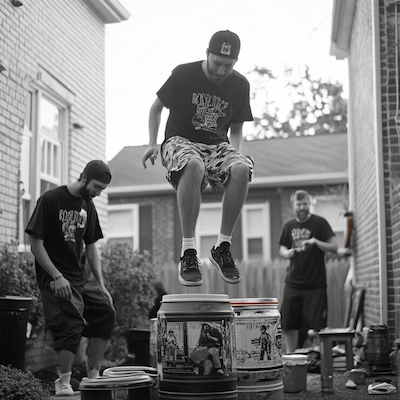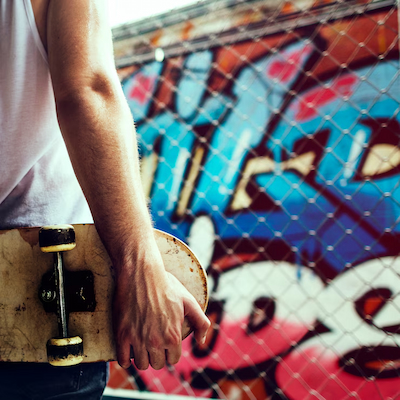
Hip Hop culture is a global phenomenon that transcends geographical and social boundaries, transforming into a true movement of artistic expression and identity. Originating in the African-American communities of the Bronx, New York, in the 1970s, this culture consists of various elements, including rap, breakdancing, graffiti, and DJing. Each of these components plays a fundamental role in constructing a collective identity that reflects the struggles, aspirations, and experiences of a generation. Over the decades, Hip Hop has evolved, incorporating influences from different cultures and styles, but always maintaining its roots in social and political issues.
Beyond its musical importance, Hip Hop culture stands out as an urban art form, serving as a means of communication and resistance. Graffiti on city walls, the beats of DJs, and the lyrics of rappers are expressions that speak to the reality experienced by many young people, addressing issues such as inequality, racism, and empowerment. Hip Hop, therefore, is not just a musical style; it is a way of life that promotes creativity, freedom of expression, and community-building. In this article, we will explore how the elements of Hip Hop culture work, the advantages of embracing this movement, and how it influences artistic expression and urban identity.
How the Elements of Hip Hop Culture Work: Sound, Identity, and Urban Art
The elements of Hip Hop culture operate in an interconnected way, forming a rich and complex network of artistic expression. Rap is the most recognizable form of Hip Hop, characterized by its rhymes and rhythms. Rappers use their lyrics to tell stories, express emotions, and address social issues. The beats accompanying rap are created by DJs and producers, who combine samples from previous songs to create an innovative and unique sound. This practice of remixing and reinterpreting music is one of Hip Hop’s fundamental characteristics, allowing artists to draw from diverse influences and create something new.
Breakdancing, another essential element of Hip Hop culture, is a dance form that combines acrobatics, fluid movements, and creativity. B-boys and B-girls use their bodies as an extension of their artistic expression, competing in battles and showcasing their skills at street events. Breakdancing is not just entertainment; it is also a way for young people to connect with their communities and express their individuality. This dance often reflects struggle and resistance, serving as a way to claim space and identity in a world that often marginalizes their voices.
Graffiti is a form of visual art that stands out in urban landscapes. Graffiti artists use city walls as their canvases, creating works that range from simple tags to complex murals. This art form is not just an aesthetic expression but also a means of communication that addresses social and political issues. Graffiti challenges norms and conventions, questioning the ownership of urban space and giving voice to communities that might otherwise be silenced. In this way, graffiti becomes a symbol of resistance and creativity, representing the struggle for recognition and identity.
All these elements—rap, breakdancing, and graffiti—are interconnected by a sense of community and belonging. Hip Hop is a space where young people from various backgrounds can come together, share experiences, and celebrate their culture. This interconnection between the different elements of Hip Hop culture creates a vibrant environment where creativity thrives and voices are amplified. Through this dynamic, Hip Hop becomes not just an art form, but a cultural movement that continues to evolve and impact society.

Advantages of Embracing Hip Hop Culture: Sound, Identity, and Urban Art in Motion
Embracing Hip Hop culture brings a range of advantages that go beyond musical appreciation. One of the main benefits is the strengthening of cultural identity. Hip Hop allows individuals to connect with their roots and traditions, promoting a sense of belonging and pride. In a globalized world where cultures can become diluted, Hip Hop offers a platform for celebrating diversity and individuality. Young people who engage with this culture have the opportunity to explore their identity, expressing themselves through music, dance, and art.
Another significant advantage is the development of creative and artistic skills. Hip Hop encourages experimentation and innovation, allowing individuals to explore different forms of expression. Whether through writing lyrics, creating beats, or painting murals, participants in Hip Hop have the opportunity to hone their skills and become well-rounded artists. This creativity not only enriches individuals’ personal lives but also contributes to the local culture, bringing fresh perspectives and ideas to the community.
Moreover, Hip Hop can be a powerful tool for education and social awareness. Many rap lyrics address important issues such as inequality, racism, and injustice, educating the public about realities that are often ignored. By engaging with Hip Hop culture, young people can become more aware of their circumstances and the issues affecting their communities. This awareness can lead to greater civic engagement, encouraging young people to become advocates for social change and fight for a more just world.
Finally, Hip Hop promotes the building of communities and support networks. Hip Hop events, such as rap battles and dance competitions, bring together people from different backgrounds, creating a space where everyone can feel welcomed. This sense of community is crucial for the social and emotional development of young people, providing a safe environment for self-expression and collaboration. By embracing Hip Hop culture, individuals not only become part of an artistic movement but also a global network that shares values of empowerment, creativity, and solidarity.
How Hip Hop Culture Influences Artistic Expression and Urban Identity
Hip Hop culture influences artistic expression and urban identity in profound and multifaceted ways. First and foremost, Hip Hop serves as a platform for the expression of marginalized voices. Through rap, artists have the opportunity to share their stories and experiences, addressing themes that resonate with their communities. This form of art becomes a tool of resistance, allowing individuals to challenge stereotypes and fight against oppression. Therefore, Hip Hop is not just a form of entertainment, but a powerful form of activism that seeks to promote social change.
Another important aspect is how Hip Hop intertwines with urban identity. Cities are often depicted in song lyrics, dance moves, and art, reflecting the realities lived by their inhabitants. Hip Hop captures the essence of urban life, addressing issues such as economic inequality, violence, and the fight for recognition. This connection to the urban environment allows artists to become spokespeople for their communities, transmitting messages that resonate with those who share similar experiences.
Additionally, Hip Hop fosters artistic innovation, encouraging creators to experiment with new forms of expression. Hip Hop artists often blend different musical genres, dance styles, and visual art techniques, resulting in a unique fusion that challenges traditional norms. This experimental approach not only enriches Hip Hop culture but also influences other art forms, creating a cycle of inspiration and creativity. In this way, Hip Hop becomes a catalyst for innovation, stimulating new ways of thinking and creating.
Lastly, Hip Hop plays a crucial role in the formation of collective identities. Through participation in events, competitions, and collaborations, individuals connect with others who share similar interests. This building of community strengthens social bonds and fosters a sense of belonging. By engaging with Hip Hop culture, young people not only develop their artistic skills but also build support networks that can last a lifetime. This interconnection between art, identity, and community is what makes Hip Hop such a powerful and enduring movement.

Did You Enjoy Learning About Hip Hop Culture: Sound, Identity, and Urban Art in Motion?
Hip Hop culture is a rich and vibrant universe that offers countless opportunities for artistic expression and identity building. By exploring its elements, such as rap, breakdancing, and graffiti, we can better understand how this culture impacts society and promotes meaningful change. Hip Hop is more than music; it is a way of life that brings people together around values of creativity, resistance, and empowerment.
We invite you to delve even deeper into this fascinating world. Discover how Hip Hop culture continues to evolve, influencing new generations and shaping the contemporary artistic landscape. By learning about and embracing this culture, you can also become part of this global movement that celebrates diversity and individual expression.
Frequently Asked Questions
What is Hip Hop culture?
Hip Hop culture is a movement that combines sound, dance, art, and fashion. It originated on the streets and spread worldwide. It is a form of expression and resistance.
What are the elements of Hip Hop culture?
The four main elements are: rap, breakdancing, graffiti, and DJing. Each one contributes to the Hip Hop identity.
How does Hip Hop culture influence people’s identity?
Hip Hop culture helps you connect with your roots. It allows you to express who you are and share your experiences. This creates a strong sense of identity.
What is the role of urban art in Hip Hop culture?
Urban art, such as graffiti, is a way to tell stories. It beautifies cities and carries powerful messages. It is a vital part of Hip Hop culture.
Is Hip Hop culture just about music?
No, Hip Hop culture is much more. It is about art, fashion, dance, and lifestyle. It is a living, evolving movement.

